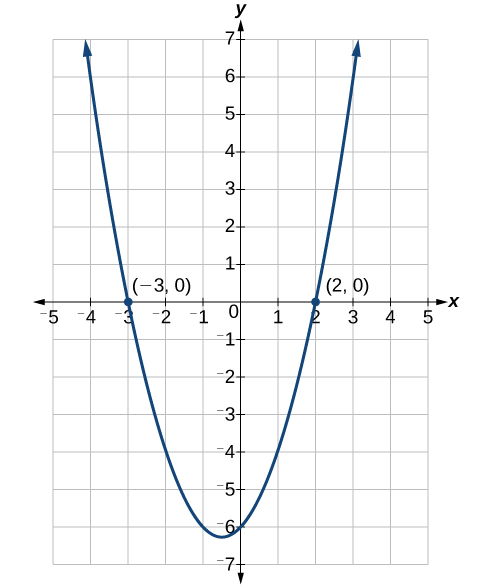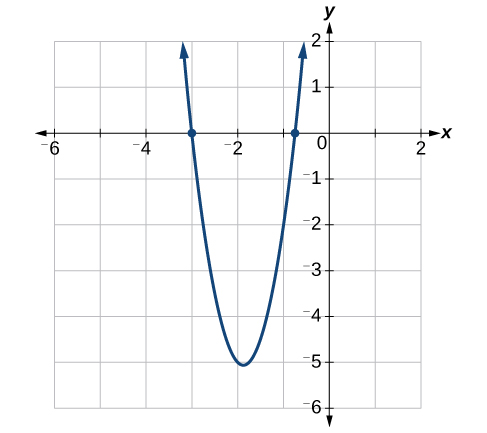Learning Outcomes
- Recognize a quadratic equation
- Use the zero product principle to solve quadratic equations that can be factored
Often the easiest method of solving a quadratic equation is by factoring. Factoring means finding expressions that can be multiplied together to give the expression on one side of the equation. Note that we will not spend a lot of time explaining how to factor in this section. You may want to seek help if you do not feel confident about factoring.
Solving by factoring depends on the zero-product property which states that if [latex]a\cdot b=0[/latex], then [latex]a=0[/latex] or [latex]b=0[/latex], where a and b are real numbers or algebraic expressions.
The process of factoring a quadratic equation depends on the leading coefficient, whether it is 1 or another integer. We will look at both situations; but first, we want to confirm that the equation is written in standard form, [latex]a{x}^{2}+bx+c=0[/latex], where a, b, and c are real numbers and [latex]a\ne 0[/latex]. The equation [latex]{x}^{2}+x - 6=0[/latex] is in standard form.
We can use the zero-product property to solve quadratic equations in which we first have to factor out the greatest common factor (GCF) and for equations that have special factoring formulas as well, such as the difference of squares, which we will see later in this section.
The Zero-Product Property and Quadratic Equations
The zero-product property states
where a and b are real numbers or algebraic expressions.
A quadratic equation is an equation containing a second-degree polynomial; for example,
where a, b, and c are real numbers, and if [latex]a\ne 0[/latex], it is in standard form.
Solving Quadratics with a Leading Coefficient of 1
In the quadratic equation [latex]{x}^{2}+x - 6=0[/latex], the leading coefficient, or the coefficient of [latex]{x}^{2}[/latex], is [latex]1[/latex]. We have one method of factoring quadratic equations in this form.
Reminder: Given a quadratic equation with the leading coefficient of 1, factor it
- Find two numbers whose product equals c and whose sum equals b.
- Use those numbers to write two factors of the form [latex]\left(x+k\right)\text{ or }\left(x-k\right)[/latex], where k is one of the numbers found in step [latex]1[/latex]. Use the numbers exactly as they are. In other words, if the two numbers are [latex]1[/latex] and [latex]-2[/latex], the factors are [latex]\left(x+1\right)\left(x - 2\right)[/latex].
- Solve using the zero-product property by setting each factor equal to zero and solving for the variable.
Example
Factor and solve the equation: [latex]{x}^{2}+x - 6=0[/latex].
In the following video, we provide more examples of factoring to solve quadratic equations.
In our next example, we will solve a quadratic equation that is written as a difference of squares.
Example
Solve the difference of squares equation using the zero-product property: [latex]{x}^{2}-9=0[/latex].
Solving Quadratics with a Leading Coefficient [latex]\ne1[/latex]
Recall that when the leading coefficient is not [latex]1[/latex], we factor a quadratic equation using a method called grouping, which requires four terms. With the equation in standard form, let us review the grouping procedures:
- With the quadratic in standard form, [latex]a{x}^{2}+bx+c=0[/latex], multiply [latex]a\cdot c[/latex].
- Find two numbers whose product equals [latex]ac[/latex] and whose sum equals [latex]b[/latex].
- Rewrite the equation replacing the [latex]bx[/latex] term with two terms using the numbers found in step [latex]2[/latex] as coefficients of x.
- Factor the first two terms and then factor the last two terms. The expressions in parentheses must be exactly the same to use grouping.
- Factor out the expression in parentheses.
- Set the expressions equal to zero and solve for the variable.
Example
Use grouping to factor and solve the quadratic equation: [latex]4{x}^{2}+15x+9=0[/latex].
The following video contains another example of solving a quadratic equation using factoring by grouping.
Sometimes, we may be given an equation that does not look like a quadratic at first glance. In our next examples we will solve a cubic polynomial equation where the GCF of each term is x and can be factored. The result is a quadratic equation that we can solve.
Example
Solve the equation by factoring: [latex]-3{x}^{3}-5{x}^{2}-2x=0[/latex].
In this last video example, we solve a quadratic equation with a leading coefficient of -1 using a shortcut method of factoring and the zero product principle.
Summary
You can find the solutions, or roots, of quadratic equations by setting one side equal to zero, factoring the polynomial, and then applying the Zero Product Property. The Principle of Zero Products states that if [latex]ab=0[/latex], then either [latex]a=0[/latex] or [latex]b=0[/latex], or both a and b are [latex]0[/latex]. Once the polynomial is factored, set each factor equal to zero and solve them separately. The answers will be the set of solutions for the original equation.
Not all solutions are appropriate for some applications. In many real-world situations, negative solutions are not appropriate and must be discarded.
Candela Citations
- Revision and Adaptation. Provided by: Lumen Learning. License: CC BY: Attribution
- College Algebra. Authored by: Abramson, Jay, et al.. Provided by: OpenStax. Located at: http://cnx.org/contents/9b08c294-057f-4201-9f48-5d6ad992740d@3.278:1/Preface. License: CC BY: Attribution. License Terms: Download for free at : http://cnx.org/contents/9b08c294-057f-4201-9f48-5d6ad992740d@3.278:1/Preface
- Ex: Solve a Quadratic Equation Using Factor By Grouping. Authored by: James Sousa (Mathispower4u.com) . Located at: https://youtu.be/04zEXaOiO4U. License: CC BY: Attribution
- Ex: Factor and Solve Quadratic Equation - Trinomial a = -1. Authored by: James Sousa (Mathispower4u.com) . Located at: https://youtu.be/nZYfgHygXis. License: CC BY: Attribution
- Unit 12: Factoring, from Developmental Math: An Open Program. Provided by: Monterey Institute of Technology and Education. Located at: http://nrocnetwork.org/dm-opentext. License: CC BY: Attribution


